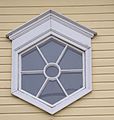Hexagonal window
A hexagonal window (also Melnikov's or honeycomb window)[1] is a hexagon-shaped window, resembling a bee cell or crystal lattice of graphite. The window can be vertically or horizontally oriented, openable or fixed. It can also be regular or elongately-shaped and can have a separator (mullion).
Typically, the cellular window[2] is used for an attic or as a decorative feature, but it can also be a major architectural element to provide the natural lighting inside buildings. The hexagonal window is relatively rare and associated with such architectural styles as constructivism,[3] functionalism[4] and, occasionally, cubism.
History
Today, hexagonal windows may be associated with honeycomb houses, a concept proposed by architect Frank Lloyd Wright[9] and explore an idea of organic architecture, which considers the nature as a main source of architectural imagination.[10][self-published source]
Gallery
-
Mustonen House, 1870, Joensuu, Finland.
-
Melnikov House, Moscow, Russia.
-
Hexagonal window with diagonal mullions,Melnikov House.
-
Vertical chain of hexagonal windows, Finland, 1950s.
-
Triple cellular window in private mansion in Finland, 1960s.
-
Internal view of hexagonal window.
-
Hexagonal window at the right bottom part of building, Finnish functionalism.
References
- ^ "About the State Melnikovs Museum". muar.ru. Schusev State Museum of Architecture. Retrieved 5 October 2016.
- ^ "Fenster kaufen" (in German). 6 October 2021.
- ISBN 978-1-4742-6506-5. Retrieved 22 June 2021.
- ISBN 978-3-7913-1936-0. Retrieved 22 June 2021.)
{{cite book}}: CS1 maint: numeric names: authors list (link - ISBN 978-0-8109-1923-5. Retrieved 22 June 2021.
- ISBN 978-5-05-001178-7. Retrieved 22 June 2021.
- ^ "The Modernist: House-studio of Konstantin Melnikov". The Constructivist Project. theconstructivistproject.com. August 31, 2014. Retrieved 4 October 2016.
- ^ Winstanley, Tim (14 June 2012). "AD Classics: Melnikov House / Konstantin Melnikov". archdaily.com. Retrieved 4 October 2016.
- ^ "About The Hanna House". Stanford University. hannahousetours.stanford.edu. Retrieved 4 October 2016.
- ISBN 978150358180-7.






